A Fully Decentralized Web Application Framework with Dynamic Multi-Point Publishing and Shortest Access Path
Abstract
1. Introduction
2. Background
2.1. Decentralized Web Application
2.2. Key Technologies
2.3. Related Work
3. Modelling
3.1. System Architecture
3.2. Dynamic Multi-Point Publishing
3.3. Shortest Access Path
3.4. Incentive and Governance
4. Workflow Design
4.1. Overall Workflow
4.2. Developer
| Algorithm 1: The process of DWeb registering and uploading to the blockchain |
| Input: DataItemDWeb: the basic information of this DWeb application Codecontract: the smart contract solidity code of this DWeb application PagefrontEnd: the front-end pages of this DWeb application Output: ResultDWeb: the process results of this DWeb application 1: web3 ← new Web3(web3URL) 2: contractFDW ← new web3.Contract(ContractFDW.ABI, ContractFDW.Address) 3: error ← contractFDW.methods.registerDWeb(DataItemDWeb).send({ from: myAccount }) 4: if error != null then 5: return error 6: contractItem ← compile(Codecontract, 1) 7: contractnew ← new web3.Contract(contractItem.ABI) 8: addrnewContract ← contractnew.deploy({data: contractItem.byteCode}).send({ from: myAccount } 9: hashpages, urlpages ← Upload(PagefrontEnd) 10: error ← contractFDW.methods.InitDWeb(addrnewContract, hashpages, urlpages).send({ from: myAccount } 11: if error != null then 12: return error 13: return true |
4.3. Publisher
| Algorithm 2: The process of DWeb publishing |
| Input: ServiceItem: the web service provided by this DWeb publisher 1: error ← contractFDW.methods.registerPublisher(ServiceItem).send({ from: myAccount }) 2: if error != null then 3: return error 4: dwebs ← contractFDW.methods.queryDWeb(ServiceItem).call() 5: for I = 0; I < Count(dwebs); i++ 6: if isCloser(dwebs[i]) then 7: pages ← download(dwebs[i].hashpages, dwebs[i].urlpages) 8: if isValid(pages) then 9: dwebURL ← deployDWeb(pages) 10: error ← contractFDW.methods.provideService(dwebURL).send({ from: myAccount }) 11: if error != null then 12: continue 13: end for 14: return true |
4.4. Visitor
5. Prototype System
5.1. Overall Design
5.2. DWeb Container
5.3. Example DWeb
6. Analysis and Evaluation
6.1. Experimental Setup
6.2. Decentralization
6.3. Scalability
6.4. Security
7. Discussion
7.1. Comparison
7.2. DWeb Supervision
7.3. Access DWeb by Domain Name
7.4. Content Search
8. Conclusions
Author Contributions
Funding
Institutional Review Board Statement
Informed Consent Statement
Data Availability Statement
Conflicts of Interest
References
- Nakamoto, S. Bitcoin: A Peer-to-Peer Electronic Cash System. 2008. Available online: https://bitcoin.org/bitcoin.pdf (accessed on 20 March 2025).
- Zeng, S.Q.; Huo, R.; Huang, T.; Liu, J.; Wang, S.; Feng, W. Survey of blockchain: Principle, progress and application. J. Commun. 2020, 41, 134–151. [Google Scholar]
- Álvarez-Díaz, N.; Herrera-Joancomartí, J.; Caballero-Gil, P. Smart contracts based on blockchain for logistics management. In Proceedings of the 1st International Conference on Internet of Things and Machine Learning, New York, NY, USA, 17–18 October 2017; pp. 73:1–73:8. [Google Scholar]
- Introduction to Smart Contracts. 2022. Available online: https://ethereum.org/en/developers/docs/smart-contracts/ (accessed on 17 September 2024).
- Weerawarna, R.; Miah, S.J.; Shao, X. Emerging advances of blockchain technology in finance: A content analysis. Pers. Ubiquitous Comput. 2023, 27, 1495–1508. [Google Scholar] [CrossRef]
- Piao, C.; Hao, Y.; Yan, J.; Jiang, X. Privacy preserving in blockchain-based government data sharing: A Service-On-Chain (SOC) approach. Inf. Process. Manag. 2021, 58, 102651. [Google Scholar] [CrossRef]
- Moosavi, J.; Naeni, L.M.; Fathollahi-Fard, A.M.; Fiore, U. Blockchain in supply chain management: A review, bibliometric, and network analysis. Environ. Sci. Pollut. Res. 2021, 2, 1–15. [Google Scholar] [CrossRef] [PubMed]
- Haleem, A.; Javaid, M.; Singh, R.P.; Suman, R.; Rab, S. Blockchain technology applications in healthcare: An overview. Int. J. Intell. Netw. 2021, 2, 130–139. [Google Scholar] [CrossRef]
- DappRadar-Discover Dapps, NFTs, GamesTokens, and Airdrops. Available online: https://dappradar.com (accessed on 13 November 2024).
- DappOnline | Discovery of the World’s DApp. Available online: https://dapponline.io/ (accessed on 20 August 2024).
- Raval, S. Decentralized Applications: Harnessing Bitcoin’s Blockchain Technology, 1st ed.; O’Reilly Media: Newton, MA, USA, 2016. [Google Scholar]
- GitHub-DistributedWeb/dweb:NewProtocol For The Decentralized Web. Available online: https://github.com/DistributedWeb/dweb (accessed on 3 January 2025).
- King, J. Net Neutrality: What to Expect From California’s Net Neutrality Bill. DePaul J. Art Technol. Intellect. Prop. Law 2019, 29, 37. [Google Scholar]
- Caldarelli, G. Overview of Blockchain Oracle Research. Future Internet 2022, 14, 175. [Google Scholar] [CrossRef]
- Wang, Q.; Li, R.; Wang, Q.; Chen, S.; Ryan, M.; Hardjono, T. Exploring web3 from the view of blockchain. arXiv 2022, arXiv:2206.08821. [Google Scholar]
- Pasdar, A.; Lee, Y.C.; Dong, Z. Connect API with Blockchain: A Survey on Blockchain Oracle Implementation. ACM Comput. Surv. 2023, 55, 1–39. [Google Scholar] [CrossRef]
- Yoon, C.; Hwang, J.; Cho, M.; Lee, B.G. Study on DID Application Methods for Blockchain-Based Traffic Forensic Data. Appl. Sci. 2021, 11, 1268. [Google Scholar] [CrossRef]
- Green, H. Introducing the DAO: The Organisation That Will Kill Corporations. May 2016. Available online: http://www.cityam.com/240198/introducing-the-dao-the-organisation-that-will-kill-corporations (accessed on 15 October 2024).
- Dos Santos, S.; Singh, J.; Thulasiram, R.K.; Kamali, S.; Sirico, L.; Loud, L. A new era of blockchain-powered decentralized finance (DeFi)—A review. In Proceedings of the 2022 IEEE 46th Annual Computers, Software, and Applications Conference (COMPSAC), Los Alamitos, CA, USA, 27 June–1 July 2022; pp. 1286–1292. [Google Scholar]
- Wang, C.; Jiang, H.; Zeng, J.; Min, Y.U.; Huang, Q.; Zuo, Z. A review of blockchain layered architecture and technology application research. Wuhan Univ. J. Nat. Sci. 2021, 26, 14. [Google Scholar]
- CryptoKitties. Available online: https://www.cryptokitties.co (accessed on 11 December 2024).
- Decentraland. Available online: https://decentraland.org (accessed on 18 December 2024).
- Benet, J. IPFS—Content Addressed, Versioned, P2P File System (DRAFT 3). 2014. Available online: https://arxiv.org/abs/1407.3561 (accessed on 3 December 2024).
- Permaweb. Available online: https://arweave.medium.com/welcome-to-the-permaweb-ce0e6c73ddfb (accessed on 13 March 2025).
- Williams, S.; Diordiiev, V.; Berman, L.; Uemlianin, I. Arweave: A protocol for economically sustainable information permanence. Arweave Yellow Pap. 2019. [Google Scholar]
- Solid. Available online: https://solidproject.org/ (accessed on 6 February 2025).
- Burak Benligiray. dAPIs: APIs for dApps. 2022. Available online: https://blog.api3.org/vision/dapis-apis-for-dapps (accessed on 26 March 2025).
- Ragab, M.; Savateev, Y.; Moosaei, R.; Tiropanis, T.; Poulovassilis, A.; Chapman, A.; Roussos, G. ESPRESSO: A Framework for Empowering Search on Decentralized Web. In Proceedings of the International Conference on Web Information Systems Engineering, Melbourne, VIC, Australia, 25–27 October 2023; pp. 360–375. [Google Scholar]
- Sambra, A.V.; Mansour, E.; Hawke, S.; Zereba, M.; Greco, N.; Ghanem, A.; Zagidulin, D.; Aboulnaga, A.; Berners-Lee, T. Solid: A platform for decentralized social applications based on linked data. MIT CSAIL Qatar Comput. Res. Inst. Tech. Rep. 2016, 2016, 1–16. [Google Scholar]
- Benshoof, B.; Rosen, A.; Bourgeois, A.G.; Harrison, R.W. Distributed decentralized domain name service. In Proceedings of the 2016 IEEE International Parallel and Distributed Processing Symposium Workshops (IPDPSW), Chicago, IL, USA, 23–27 May 2016; pp. 1279–1287. [Google Scholar]
- Kalodner, H.A.; Carlsten, M.; Ellenbogen, P.M.; Bonneau, J.; Narayanan, A. An Empirical Study of Namecoin and Lessons for Decentralized Namespace Design. WEIS 2015, 1, 1–23. [Google Scholar]
- Bauer, D.P. Ethereum Name Service. In Getting Started with Ethereum: A Step-by-Step Guide to Becoming a Blockchain Developer; Apress: Berkeley, CA, USA, 2022; pp. 103–106. [Google Scholar]
- Decentralized Naming and Certificate Authority. Available online: https://handshake.org (accessed on 9 March 2025).
- Singh, R.; Donegan, A.; Tewari, H. Framework for a Decentralized Web. In Proceedings of the 2020 30th International Telecommunication Networks and Applications Conference (ITNAC), Melbourne, VIC, Australia, 25–27 November 2020; pp. 1–7. [Google Scholar]
- Dabek, F.F.E. A Distributed Hash Table. Ph.D. Thesis, Massachusetts Institute of Technology, Cambridge, MA, USA, 2005. [Google Scholar]
- Getting Started with Geth. Available online: https://geth.ethereum.org/docs/getting-started (accessed on 19 October 2024).
- Ren, L. Proof of Stake Velocity: Building the Social Currency of the Digital Age. 2014. Available online: https://wiki.reddcoin.com/Proof_of_Stake_Velocity_(PoSV) (accessed on 22 May 2023).
- Wang, Y.; Gou, G.; Liu, C.; Cui, M.; Li, Z.; Xiong, G. Survey of security supervision on blockchain from the perspective of technology. J. Inf. Secur. Appl. 2021, 60, 102859. [Google Scholar] [CrossRef]
- Luu, L.; Narayanan, V.; Zheng, C.; Baweja, K.; Gilbert, S.; Saxena, P. A Secure Sharding Protocol for Open Blockchains. In Proceedings of the 2016 ACM SIGSAC Conference on Computer and Communications Security, CCS ‘16, New York, NY, USA, 24–28 October 2016; pp. 17–30. [Google Scholar]
- Kokoris-Kogias, E.; Jovanovic, P.; Gasser, L.; Gailly, N.; Syta, E.; Ford, B. Omniledger: A Secure, Scale-out, Decentralized Ledger via Sharding. In Proceedings of the 2018 IEEE Symposium on Security and Privacy (SP), San Francisco, CA, USA, 20–24 May 2018; pp. 583–598. [Google Scholar]
- Zamani, M.; Movahedi, M.; Raykova, M. RapidChain: Scaling Blockchain via Full Sharding. In Proceedings of the 2018 ACM SIGSAC Conference on Computer and Communications Security, CCS ‘18, New York, NY, USA, 15–19 October 2018; pp. 931–948. [Google Scholar]
- Xu, C.; Zhang, C.; Xu, J.; Pei, J. SlimChain: Scaling blockchain transactions through off-chain storage and parallel processing. Proc. VLDB Endow. 2021, 14, 2314–2326. [Google Scholar] [CrossRef]
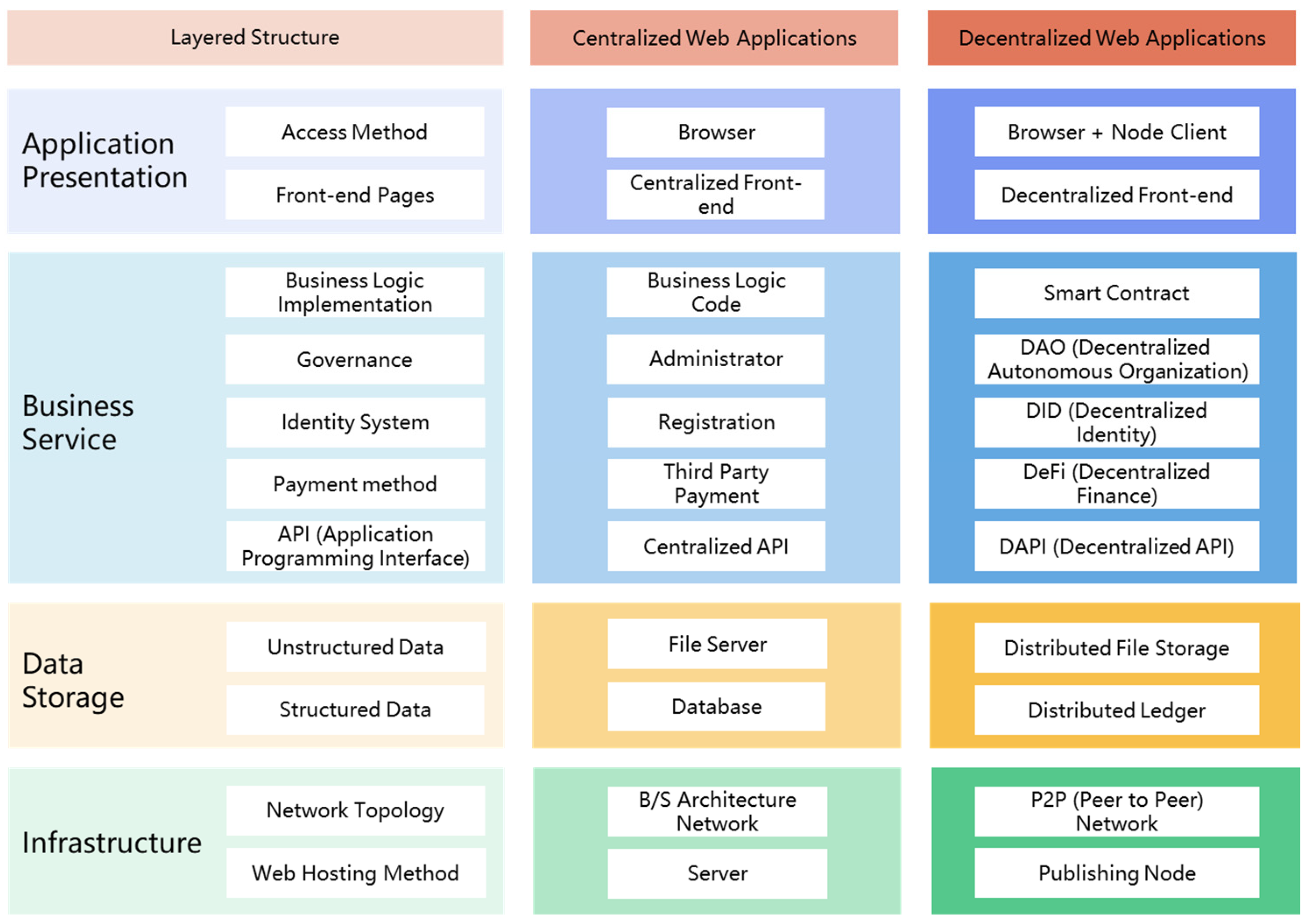
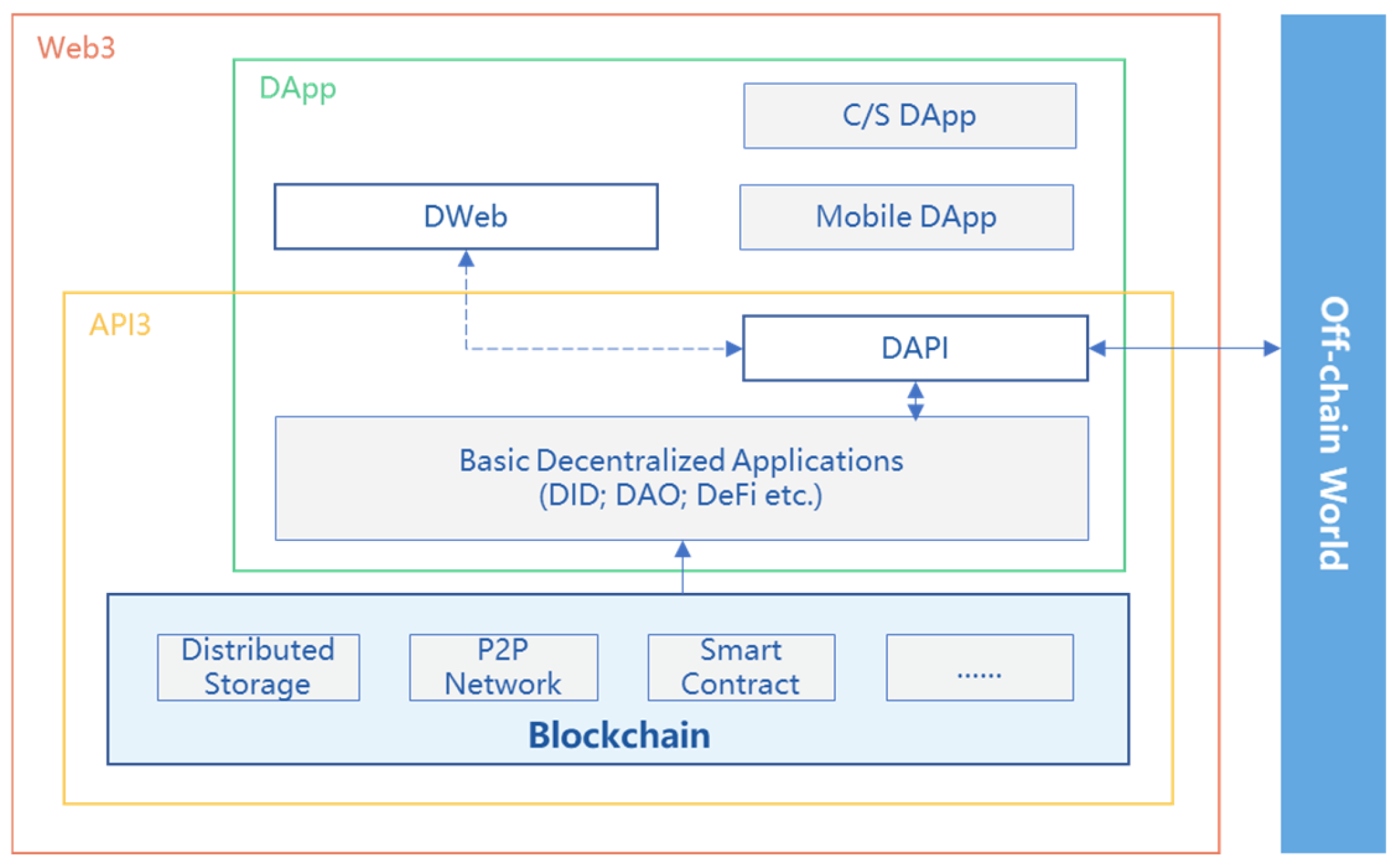
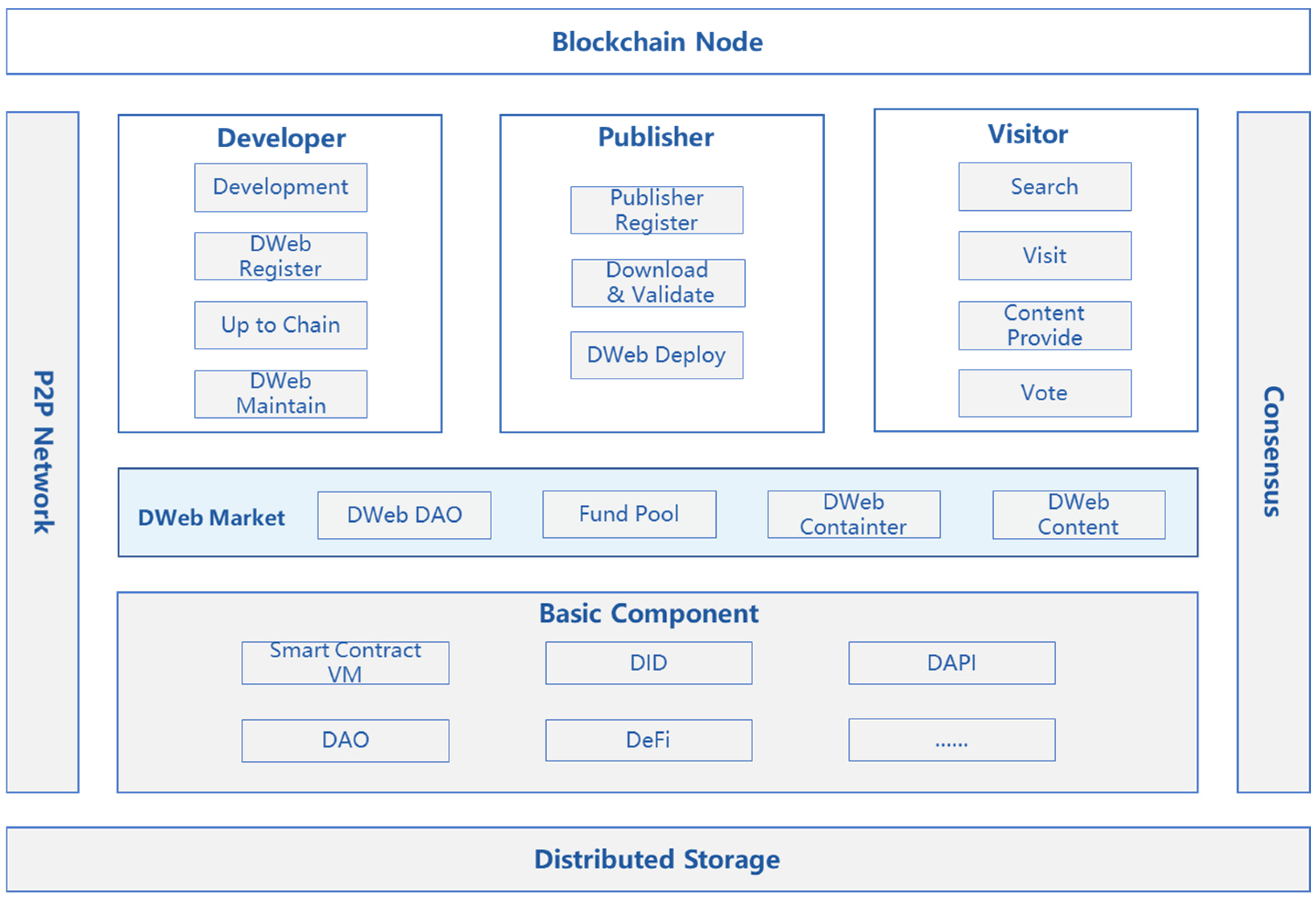

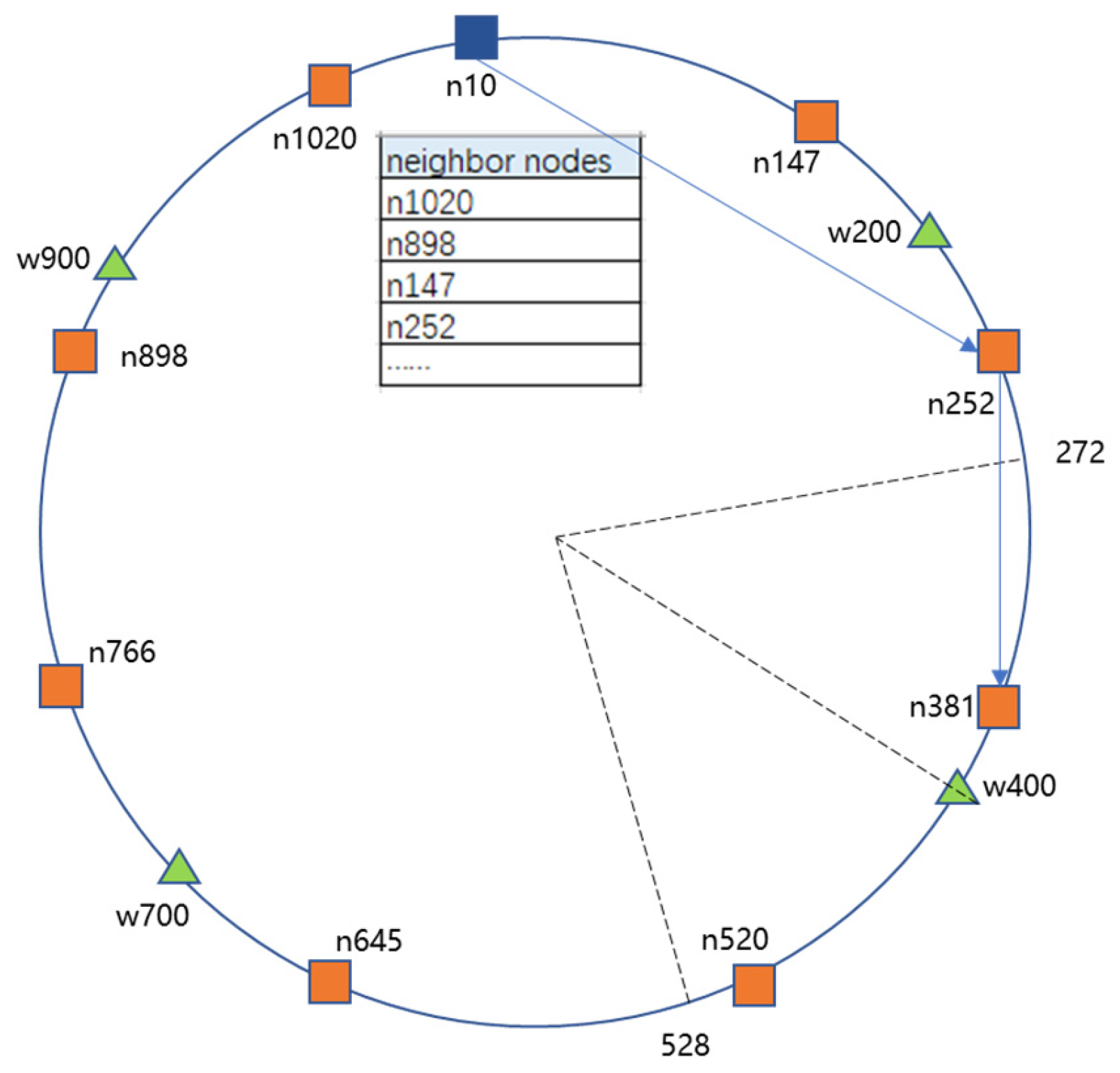
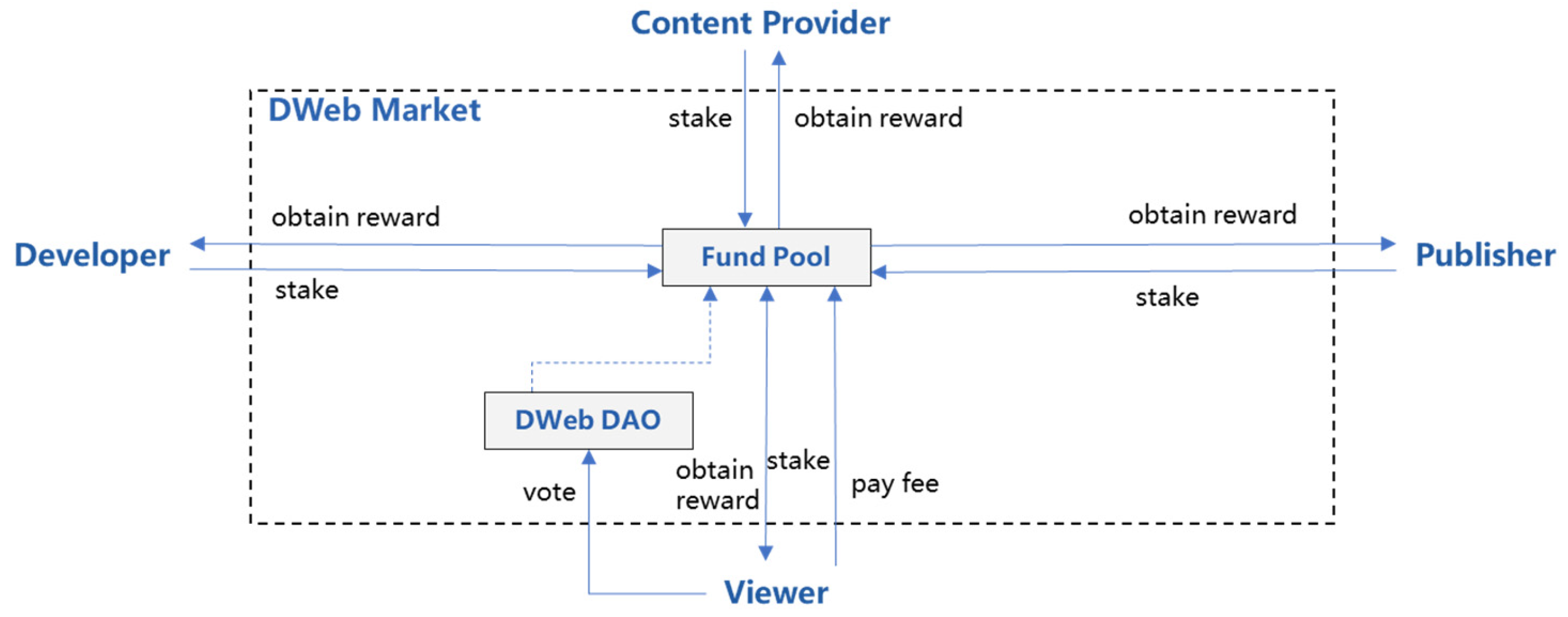
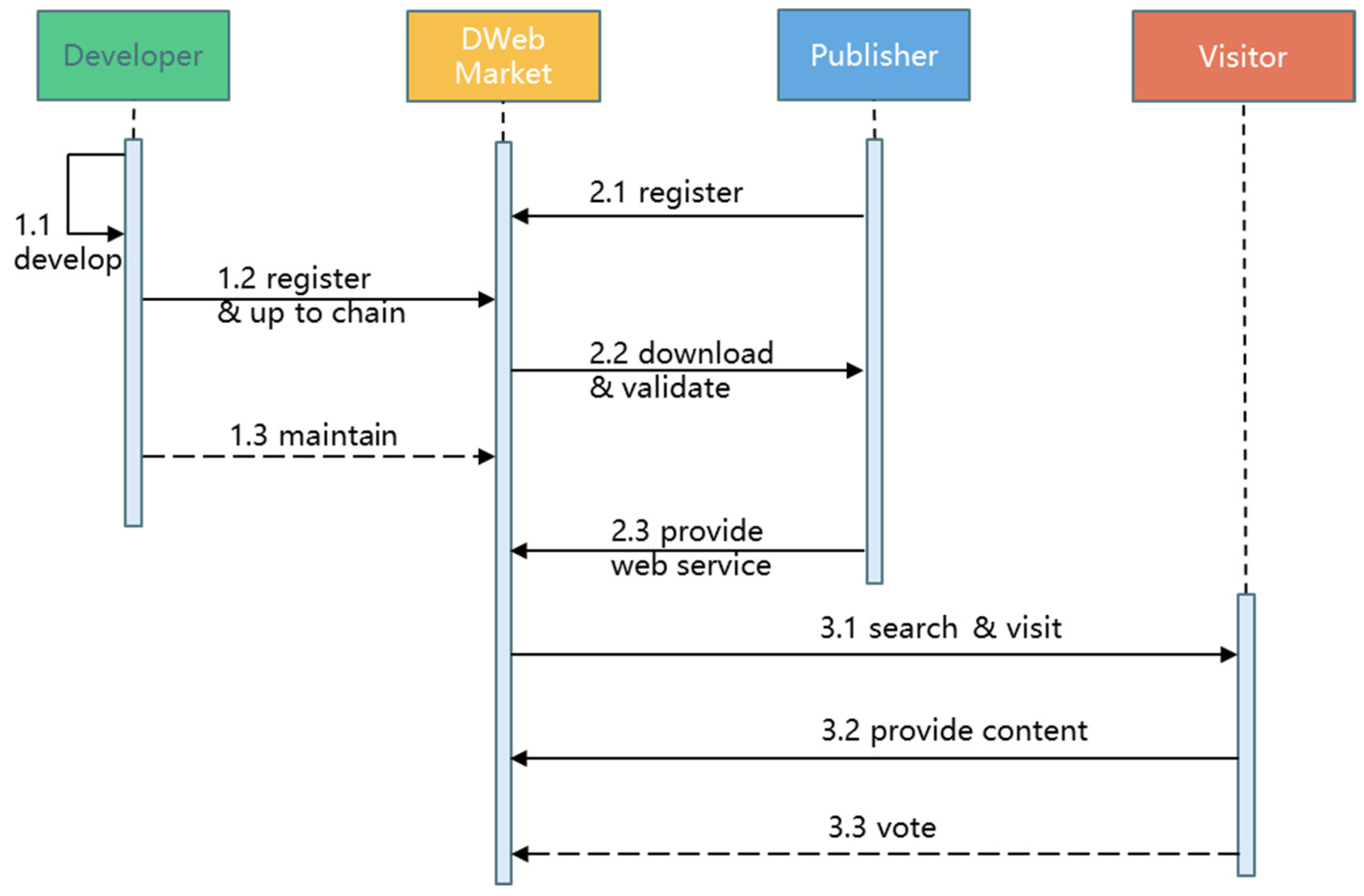


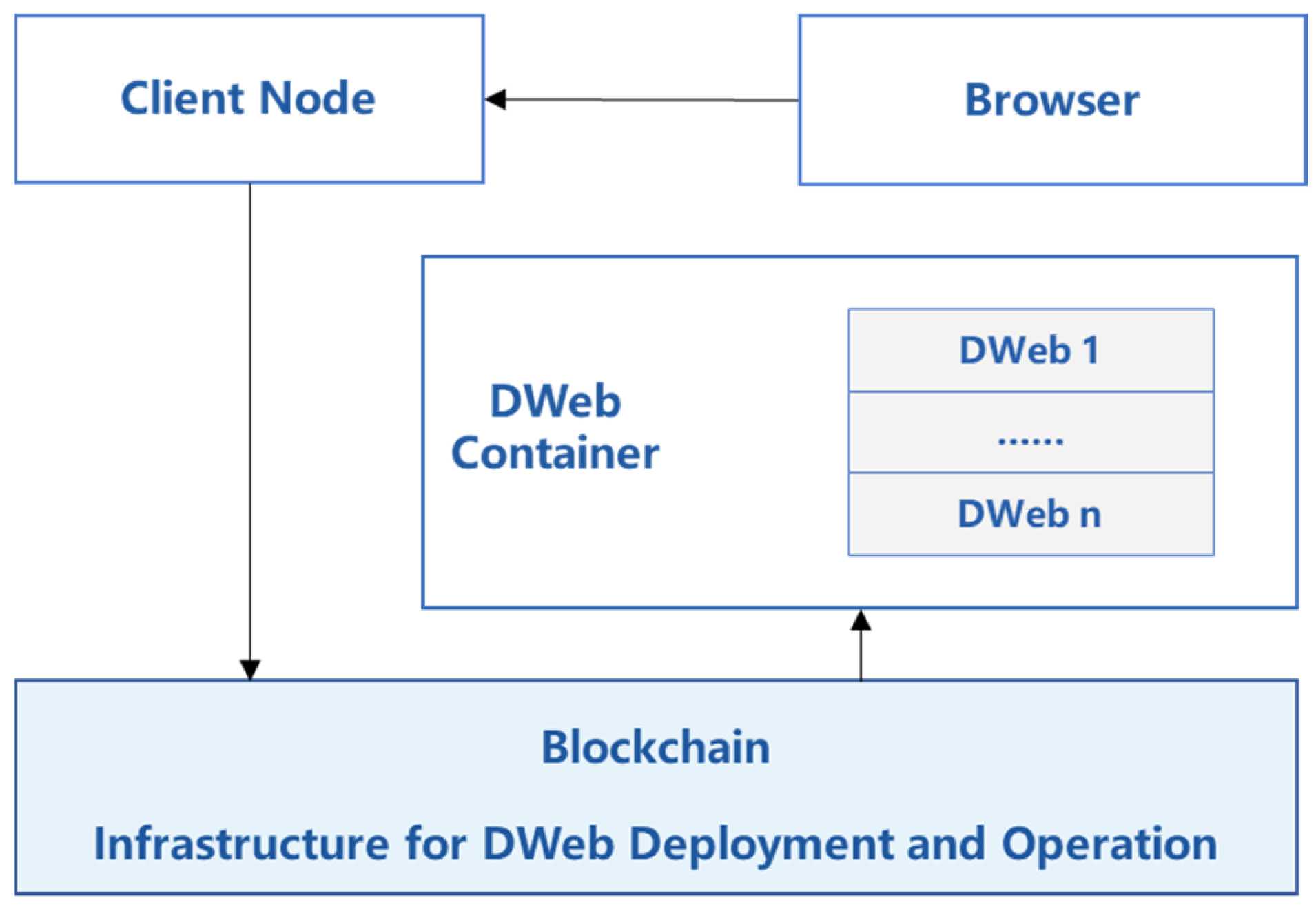
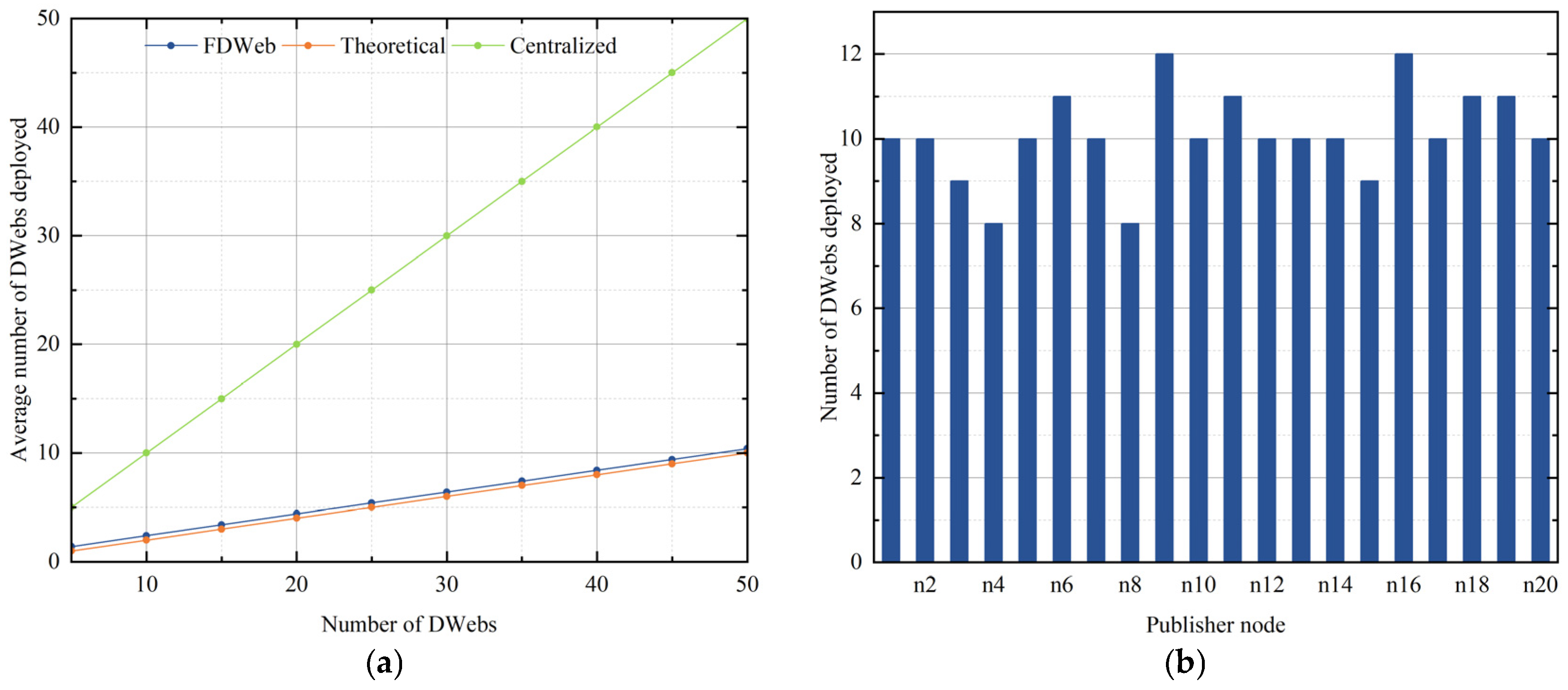



| DWeb (Distance) | Publisher Node | Distance | Stored |
|---|---|---|---|
| w900 (134) | n1020 | 14 | Y |
| n898 | 136 | Y | |
| n147 | 137 | N | |
| n645 | 389 | N | |
| w200 (190) | n1020 | 14 | Y |
| n147 | 137 | Y | |
| n252 | 242 | N | |
| n381 | 371 | N | |
| w700 (334) | n898; n766; n645; n520 | 136; 268; 389; 510 | N |
| w400 (390) | n252; n381; n645; n520 | 242; 371; 389; 510 | N |
| Data Item | Size (Bytes) | Remark |
|---|---|---|
| DWeb Id | 8 | The unique identifier of a DWeb in the DWeb market |
| Deploy Type | 4 | DWeb type that publisher nodes can deploy |
| Title | 32 | The unique title of the current DWeb |
| Category | 4 | The category of the current DWeb |
| Description | 128 | Detailed description of the current DWeb functions, features, etc. |
| Developer | 32 | The developer of the current DWeb |
| Upload Time | 8 | The time that the current DWeb is first uploaded to the blockchain |
| Contract Address | 32 | The address of the smart contract that implements the current DWeb business logic code |
| Pages Hash | 32 | Hash value of all DWeb front-end pages |
| Pages download URL | 32 | The front-end pages’ download addresses of the current DWeb |
| Publishing URL List | 32 × n | The list of all publishing URL addresses |
| Version | 8 | The version of the current DWeb |
| Data Item | Size (Bytes) | Remark |
|---|---|---|
| DWeb ID | 8 | The unique identifier of a DWeb in the DWeb market |
| Title | 32 | The unique title of the current DWeb |
| Description | 128 | Detailed description of the current DWeb functions, features, etc. |
| Developer | 32 | The developer of the current DWeb |
| Create Time | 8 | The time that the current DWeb is first uploaded to the blockchain |
| Version | 8 | The version of the current DWeb |
| Comments List | 32 × n | The list of all publishing URL addresses |
| Parameter | Value | Remark |
|---|---|---|
| 256 | The bit length of node ID and DWeb ID | |
| 100 | The number of all nodes in the blockchain p2p network | |
| The maximum number of each node storing neighbor nodes | ||
| 20 | The number of publisher nodes | |
| 4 | The number of the example DWeb needs to be published |
| Schemes | Example | Decentralization | Scalability | Security |
|---|---|---|---|---|
| Traditional centralized web | github.com | Low | Poor | Low |
| Distributed file storage system [23] | IPFS [23] | Medium | Excellent | High |
| API3 [27] | api3.org [27] | Medium | Medium | Medium |
| DApp [10] | cryptokitties.co [21] | Business logic (✓) Front-pages (✕) | Poor | High |
| DWeb [12] | PermaWeb [24] | High | Poor | High |
| FDW (ours) | FDW | Full | Excellent | High |
Disclaimer/Publisher’s Note: The statements, opinions and data contained in all publications are solely those of the individual author(s) and contributor(s) and not of MDPI and/or the editor(s). MDPI and/or the editor(s) disclaim responsibility for any injury to people or property resulting from any ideas, methods, instructions or products referred to in the content. |
© 2025 by the authors. Licensee MDPI, Basel, Switzerland. This article is an open access article distributed under the terms and conditions of the Creative Commons Attribution (CC BY) license (https://creativecommons.org/licenses/by/4.0/).
Share and Cite
Yu, B.; Fan, Y.; Zhao, P.; Li, X.; Chen, L. A Fully Decentralized Web Application Framework with Dynamic Multi-Point Publishing and Shortest Access Path. Information 2025, 16, 391. https://doi.org/10.3390/info16050391
Yu B, Fan Y, Zhao P, Li X, Chen L. A Fully Decentralized Web Application Framework with Dynamic Multi-Point Publishing and Shortest Access Path. Information. 2025; 16(5):391. https://doi.org/10.3390/info16050391
Chicago/Turabian StyleYu, Bin, Yuhui Fan, Peng Zhao, Xiaoyan Li, and Lei Chen. 2025. "A Fully Decentralized Web Application Framework with Dynamic Multi-Point Publishing and Shortest Access Path" Information 16, no. 5: 391. https://doi.org/10.3390/info16050391
APA StyleYu, B., Fan, Y., Zhao, P., Li, X., & Chen, L. (2025). A Fully Decentralized Web Application Framework with Dynamic Multi-Point Publishing and Shortest Access Path. Information, 16(5), 391. https://doi.org/10.3390/info16050391






